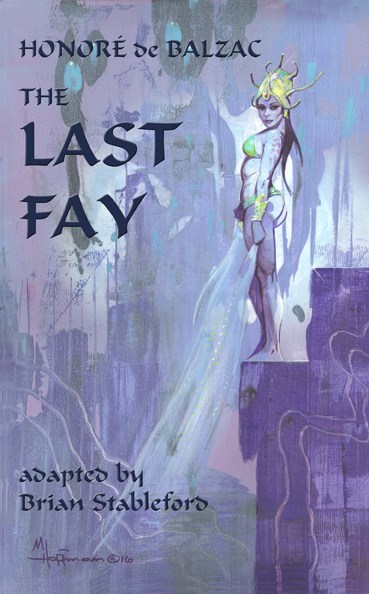Review by Glenn Russell
Originally published under
a pseudonym in 1823 when the great French author was but age twenty-four,
The Last Fay (La Dernière Fée) is a unique blend of fantasy
and folklore, a tale of enchantment and breathtaking beauty along with
a few highly unexpected turns. In this new Black Coat Press edition, scholar
and translator Brian Stableford provides historical and cultural context
to more fully appreciate Honoré de Balzac’s bold literary
experimentation.
With this early novel Blazac
experimented primarily in two respects. First, he wanted to flex his authorial
muscles to see how far he could play off his readers' expectations. On
this point to say anything more would be to say too much so as to spoil.
You will simply have to read The Last Fay for yourself to fathom how far
Balzac was willing to extend his literary freedom right up to the last
page. What I will say is that anyone familiar with his later novel of
fantasy and wish-granting, The Magic Skin (La Peau de Chagrin), will be
surprised at the different ways magic and wish-granting weave and eventually
knot various narrative strands in The Last Fay. I myself was thrown for
a loop a few times.
Balzac’s second experimentation
relates to the novel’s main character, Abel, a twenty-year old raised
by his mother and father out in nature, far removed from anything approaching
the corrupting influence of society or civilization. In this respect Abel
is very much a “Child of Nature” in the sense envisioned by
Francophone Genevan philosopher, Jean-Jacques Rousseau. And ever since
the time of Rousseau, many the novels written either supporting or slamming
the influential thinker's philosophic vision of how humans by nature are
good and how civilization corrupts, the most famous example the early
twentieth century character of Tarzan created by American author Edgar
Rice Burroughs.
In The Last Fay Balzac takes
this “Child of Nature” theme and adds a critical twist: >From
an early age Abel is also exposed to Cabinet des fées, an illustrated
book of folklore, fantasy tales of kings and queens, princes and princesses,
goblins and sprites, fairies and jinn, and most especially of fays, those
beautiful young enchantresses from an otherworldly realm of magic. Indeed,
Abel’s mother and father read the book to him again and again until
after years of repetition, Abel not only gazes at the illustrations but
can read the words himself. And, perhaps not surprisingly for such an
innocent, Abel comes to believe wholeheartedly in the reality of the creatures
described therein, especially the fays.
Out in the forest, the first
people Abel comes in contact with are, of course, his parents. His father
is a gifted, ingenious chemist and his mother a loving supporter of her
husband. Also, there is Caliban, their faithful servant who also adores
the son from the day of the beautiful boy’s birth. Here is how Blazac
describes Abel: “His fiery eyes radiated candor and innocence, his
brow, as pure as Diana’s and as pale as ivory, brought out the jet-black
of his hair, which fell in waves over his snow-white shoulders. His face
had the flower of youth, the vivacity of color and elasticity of the features,
the virginal appearance and gracious pride, which realize in our eyes
the idea we have of young Greeks or angels.”
Alas, the day comes when Abel,
now a young man, is alone with Caliban. His wise, loving father fell asleep
and was exposed to deadly fumes in his laboratory and his mother died
of heartache shortly thereafter. I’m not giving anything away since
these events occur in the first couple of chapters and Balzac himself
speaks directly to the reader, noting how at this point in the drama the
real story he is telling takes place. Actually, I found the author addressing
readers in this way rather charming. Anyway, some days pass when an attractive
young peasant girl by the name of Catherine makes her way through the
forest to the rock where Abel is sitting. I trust nobody will be surprised
to learn – fanfare with panpipes – Catherine immediately falls
in love with the handsome lad of nature.
The tale moves apace with Abel
and Catherine and then it happens one moonlit evening when Abel is alone
outside his cottage – a fay appears! Oh, my goodness, does the plot
begin to thicken. To further whet your appetite and share the sumptuousness
of the novel's language, I will let Honoré de Balzac have the last
words: “She had jet-black hair, dotted with pearls whose charming
whiteness, softer than that of diamond, made her head resemble a tuft
of verdure charged with a thousand dewdrops. A girdle of pearls circled
a slender, light and voluptuous waist; a pearl necklace with fifteen rows
was only distinguished with difficulty by Abel, because it seemed to be
confused with the fay’s skin, so white was she; on her polished arms,
delicate and satined, pearl bracelets gleamed; and her dress was embroidered
with pearls. She was holding a wand of mother-of-pearl, and from the summit
of her head a veil hung down at the back, so light that it seemed to be
woven from the wind by the zephyrs themselves. That veil, milk-white,
formed in its play a kind of cloud, in the bosom of which she was seated.”
Again, I wouldn’t want
to say anything so as to spoil but I will add how, as Brian Stableford
remarks, Balzac took this story of the fay and moved in the direction
of a “happy ever after” fairy tale ending, however he wanted
to accomplish something more daring, more complex, a unique combination
of the traditional Beauty and the Beast story and narrative themes foreshadowing
the realism and tragic dimensions of life he made so much a part of his
La Comédie humaine. How exactly? I highly recommend you read The
Last Fay to find out.
|


